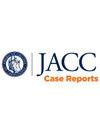束状室性心动过速患者巨细胞心肌炎的早期识别
Q4 Medicine
引用次数: 0
摘要
巨细胞心肌炎(GCM)是一种罕见的、进展迅速的炎症性心肌病,通常表现为室性心律失常或心力衰竭。早期识别和免疫抑制治疗对改善预后至关重要。病例总结一名65岁男性接受髋关节手术术前评估,发现有广泛性复杂心动过速。他说有心悸和头晕,但否认胸痛。肌钙蛋白显著升高(5206 ng/L,峰值5647 ng/L)。经胸超声心动图显示左心室射血分数降低(35%-40%),心脏磁共振提示心肌炎。心肌内膜活检证实GCM。患者开始使用脉冲剂量类固醇、他克莫司和霉酚酸酯,肌钙蛋白水平迅速下降表明病情迅速改善。他最终被列入了心脏移植名单。cm常表现为室性心律失常和快速临床恶化。本病例强调了认识到心肌炎是室性心动过速的原因的重要性,特别是在肌钙蛋白升高和非阻塞性冠状动脉疾病的患者中。早期诊断和免疫抑制是改善预后的关键。考虑室性心动过速、高肌钙蛋白和非阻塞性冠状动脉疾病患者的心肌炎。早期识别和免疫抑制治疗是治疗GCM的关键。心脏磁共振和活检是诊断的必要条件。由于相关的高死亡率,所有GCM病例都应考虑原位心脏移植。本文章由计算机程序翻译,如有差异,请以英文原文为准。
Early Recognition of Giant Cell Myocarditis in a Patient With Fascicular Ventricular Tachycardia
Background
Giant cell myocarditis (GCM) is a rare, rapidly progressive inflammatory cardiomyopathy, often manifesting with ventricular arrhythmias or heart failure. Early recognition and immunosuppressive therapy are crucial for improving outcomes.
Case Summary
A 65-year-old man undergoing preoperative evaluation for hip surgery was found to have a wide complex tachycardia. He reported palpitations and dizziness but denied chest pain. Troponin was significantly elevated (5,206 ng/L, peaking at 5,647 ng/L). Transthoracic echocardiography showed reduced left ventricular ejection fraction (35%-40%), and cardiac magnetic resonance suggested myocarditis. Endomyocardial biopsy confirmed GCM. The patient was started on pulse-dose steroids, tacrolimus, and mycophenolate mofetil, resulting in swift improvement as indicated by rapidly downtrending troponin levels. He was ultimately listed for heart transplantation.
Discussion
GCM often manifests with ventricular arrhythmias and rapid clinical deterioration. This case underscores the importance of recognizing myocarditis as a cause of ventricular tachycardia, particularly in patients with elevated troponins and nonobstructive coronary artery disease. Early diagnosis and immunosuppression are key to improving prognosis.
Take-Home Messages
Consider myocarditis in patients with ventricular tachycardia and high troponins and nonobstructive coronary artery disease. Early recognition and immunosuppressive therapy are critical for management of GCM. Cardiac magnetic resonance and biopsy are essential for diagnosis. Orthotopic heart transplantation should be considered in all cases of GCM owing to the associated high mortality rates.
求助全文
通过发布文献求助,成功后即可免费获取论文全文。
去求助
来源期刊

JACC. Case reports
Medicine-Cardiology and Cardiovascular Medicine
CiteScore
1.30
自引率
0.00%
发文量
404
审稿时长
17 weeks
 求助内容:
求助内容: 应助结果提醒方式:
应助结果提醒方式:


